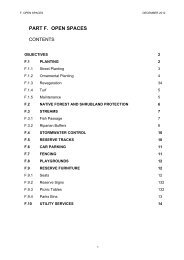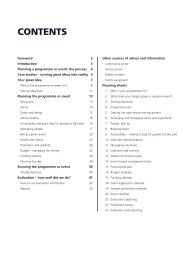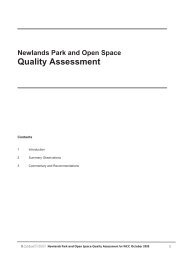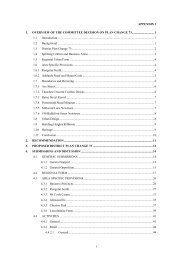Achieving Excellence in Food Safety - Wellington City Council
Achieving Excellence in Food Safety - Wellington City Council
Achieving Excellence in Food Safety - Wellington City Council
Create successful ePaper yourself
Turn your PDF publications into a flip-book with our unique Google optimized e-Paper software.
Mel<strong>in</strong>da Sando show<strong>in</strong>g ways to reduce risks when prepar<strong>in</strong>g and<br />
serv<strong>in</strong>g food to customers.<br />
Chris F<strong>in</strong>layson dos<strong>in</strong>g an actimatic grease converter down the<br />
kitchen s<strong>in</strong>k.<br />
Hemi Tahu and Randy Lo discuss<strong>in</strong>g a clean<strong>in</strong>g schedule check.<br />
<strong>Food</strong> hygiene tra<strong>in</strong><strong>in</strong>g<br />
Enrol the manager and at least 50% of the kitchen staff <strong>in</strong> a course<br />
that covers basic food hygiene tra<strong>in</strong><strong>in</strong>g. Keep copies of the certificates<br />
on site.<br />
Pest control<br />
Proactive pest control is essential to ensure that any chance <strong>in</strong>festation<br />
can be rapidly controlled. All records of treatments need to be kept<br />
on the premises. Records need to <strong>in</strong>clude <strong>in</strong>formation about<br />
conditions observed by the pest control operator and nature of<br />
treatments carried out.<br />
Ma<strong>in</strong>tenance<br />
Rout<strong>in</strong>e ma<strong>in</strong>tenance ensures that your premises and equipment<br />
are perform<strong>in</strong>g at their best when you need them. Pest control is<br />
more easily achieved <strong>in</strong> premises “without gaps”. Records of<br />
ma<strong>in</strong>tenance, particularly on mach<strong>in</strong>ery, ensure that an efficient<br />
ma<strong>in</strong>tenance programme can be followed.<br />
Identify<strong>in</strong>g risks <strong>in</strong> food process<strong>in</strong>g<br />
It is important that the food processes used <strong>in</strong> your premises are<br />
assessed and monitored. Any areas where there is a risk that can<br />
be controlled need to be documented and all staff made aware of<br />
steps to be taken to control or m<strong>in</strong>imise risks. Development of a<br />
programme to manage risks heightens the awareness of staff to<br />
those risks and is an important step <strong>in</strong> ensur<strong>in</strong>g food safety.<br />
If you have any queries or would like more <strong>in</strong>formation<br />
you can:<br />
• contact your Environmental Health Officer on 499 4444<br />
• email us at bcls@wcc.govt.nz<br />
• visit our website, www.Well<strong>in</strong>gton.govt.nz<br />
• come <strong>in</strong> and see us at 101 Wakefield Street, Well<strong>in</strong>gton.<br />
Well<strong>in</strong>gton <strong>City</strong> <strong>Council</strong> wishes to thank Eurest NZ Ltd, Monsoon<br />
Poon, Kwiksnax, Stella and <strong>Food</strong> <strong>Safety</strong> Works for their assistance<br />
<strong>in</strong> prepar<strong>in</strong>g this publication.<br />
Front cover: Lance Keat<strong>in</strong>g display<strong>in</strong>g his new certificate of excellence.<br />
PDWCC60862<br />
<strong>Achiev<strong>in</strong>g</strong> excellence<br />
<strong>in</strong> food safety
An excellent d<strong>in</strong><strong>in</strong>g experience depends on you<br />
Well<strong>in</strong>gton <strong>City</strong> has a reputation as the café capital of New Zealand.<br />
An <strong>in</strong>tegral part of this reputation is the top quality food and premises we have on offer. The <strong>Council</strong> recognises excellent<br />
performance with a certificate of excellence.<br />
We are often asked how an operator can achieve a certificate show<strong>in</strong>g they have achieved excellence <strong>in</strong> their premises.<br />
This brochure shows how you can take steps to work with us to improve the standards <strong>in</strong> food premises. Legislation<br />
is shift<strong>in</strong>g the emphasis to performance-based assessment. You need to demonstrate to us that you have put <strong>in</strong> place<br />
a best practice hygiene regime.<br />
How to get and keep your certificate of<br />
excellence<br />
Well<strong>in</strong>gton <strong>City</strong> <strong>Council</strong> awards certificates of excellence to food<br />
premises that demonstrate high food safety standards.<br />
To receive a certificate of excellence, premises operators need<br />
to have:<br />
• staff tra<strong>in</strong>ed <strong>in</strong> food hygiene<br />
• an effective clean<strong>in</strong>g programme<br />
• well-ma<strong>in</strong>ta<strong>in</strong>ed premises<br />
• good personal hygiene practices<br />
• safe food storage and display<br />
• regular temperature checks<br />
• effective pest control<br />
• regularly ma<strong>in</strong>ta<strong>in</strong>ed equipment.<br />
We will assess your performance.<br />
Hemi Tahu r<strong>in</strong>s<strong>in</strong>g dishes prior to mach<strong>in</strong>e wash<strong>in</strong>g.<br />
All registered food premises are graded every year. Premises that<br />
score highly (<strong>in</strong> the 17-20 range) dur<strong>in</strong>g the grad<strong>in</strong>g <strong>in</strong>spection<br />
can be eligible for a certificate of excellence. A certificate is issued<br />
only to the current operator who, as a result, enjoys a discounted<br />
licence fee for the excellence grad<strong>in</strong>g. If you sell your bus<strong>in</strong>ess, the<br />
new operators will have to earn their own excellent grade.<br />
To keep the excellent grade, a consistently high score (<strong>in</strong> the 17-20<br />
range) is required. Should the standards drop, the excellent grade<br />
will be withdrawn and improved ongo<strong>in</strong>g standards must be<br />
demonstrated before it can be re<strong>in</strong>stated.<br />
Risk Factors<br />
<strong>Excellence</strong> criteria are used dur<strong>in</strong>g the assessment with<strong>in</strong> the<br />
follow<strong>in</strong>g risk factors: conduct, premises, clean<strong>in</strong>g and tra<strong>in</strong><strong>in</strong>g.<br />
The marks out of five for each risk factor are then totalled. A mark<br />
of at least four is necessary for each risk factor and at least one<br />
needs to be a five to get a sufficiently high score to achieve excellence.<br />
Temperatures<br />
The temperature that food is stored at is crucial for food safety.<br />
Refrigerators should be kept at 4°C or less, freezers -18°C or less and<br />
hot food 60°C or more.<br />
Use an accurate thermometer to measure the temperatures <strong>in</strong>side all<br />
refrigeration and heat<strong>in</strong>g appliances, ie display units, freezers, pie<br />
warmers, ba<strong>in</strong>-maries, etc.<br />
This should be done at least three times a day at regular <strong>in</strong>tervals.<br />
Keep a written record of the temperatures, where they were taken,<br />
the time they were taken and the date.<br />
<strong>Food</strong> on display<br />
Chill cold food to 4°C or less and heat hot food to 60°C or more.<br />
<strong>Food</strong> displayed <strong>in</strong> a refrigerated cab<strong>in</strong>et allows the storage time to<br />
be safely extended and reduces the risk of food be<strong>in</strong>g exposed for<br />
unknown extended periods at room temperature.<br />
Check regularly that hot food on display is stored at 60°C or more.<br />
Ba<strong>in</strong>-marie food needs to be stirred and replaced frequently to keep<br />
it at a safe temperature. Do not use the ba<strong>in</strong>-marie to heat food. Both<br />
the food and the ba<strong>in</strong>-marie must be hot before used for display.<br />
Hygienic practices<br />
All staff need to wear suitable protective<br />
cloth<strong>in</strong>g, with hair short, tied back or <strong>in</strong><br />
nets/hats. A ‘sickness’ policy is essential to<br />
ensure staff do not work when they are sick.<br />
Frequent hand wash<strong>in</strong>g needs to be part of<br />
every staff member’s rout<strong>in</strong>e. New staff need<br />
to have high risk steps <strong>in</strong> the process<strong>in</strong>g of food<br />
expla<strong>in</strong>ed, to make sure that hand wash<strong>in</strong>g is<br />
used to break the cha<strong>in</strong> of <strong>in</strong>fection. Hand<br />
wash<strong>in</strong>g equipment (soap, suitable towels,<br />
nailbrush, water 38-55°C) must be accessible<br />
at all times and hand wash<strong>in</strong>g technique needs<br />
to be demonstrated/supervised to ensure<br />
effective control.<br />
Clean<strong>in</strong>g schedule<br />
You need to provide a clean<strong>in</strong>g schedule<br />
describ<strong>in</strong>g the method of clean<strong>in</strong>g, the clean<strong>in</strong>g<br />
materials that will be used, how often it will<br />
be done and who is responsible. Suitable<br />
storage facilities for clean<strong>in</strong>g materials, separate<br />
from all food and food equipment/packag<strong>in</strong>g,<br />
are essential.<br />
Completion of duties should be visually checked,<br />
dated and signed off daily by management.<br />
Keep a written record for future reference.<br />
Sanitisers must be used on all food preparation<br />
surfaces and equipment, on at least a daily<br />
basis. Instruction on use and frequency should<br />
be <strong>in</strong>cluded <strong>in</strong> the clean<strong>in</strong>g schedule. Charles Chia check<strong>in</strong>g refrigerated food - readily perishable food needs to be at 4 o C or less.<br />
Keep all food covered to protect it from sneezes, coughs, dust<br />
and <strong>in</strong>sects.<br />
Hot water temperature<br />
The temperature of the hot water at all kitchen s<strong>in</strong>ks must be at least<br />
63°C, throughout the day’s operation. Use an accurate thermometer<br />
to check this at least once a month.<br />
Include these results on your clean<strong>in</strong>g plan.<br />
Dishwashers and glasswashers<br />
Dishwashers should wash at a m<strong>in</strong>imum temperature of 60°C and<br />
r<strong>in</strong>se at a m<strong>in</strong>imum of 77°C, for at least 10 seconds.<br />
Dishwashers and glasswashers must have automatic detergent<br />
pumps and dish racks or trays that are not rusty or chipped.<br />
The mach<strong>in</strong>es must operate at the above temperatures at<br />
all times.<br />
Service the mach<strong>in</strong>es twice a year, regularly check that the r<strong>in</strong>se<br />
cycle is work<strong>in</strong>g and check the condition of the trays. Keep a record<br />
of ma<strong>in</strong>tenance and servic<strong>in</strong>g.<br />
Hemi Tahu check<strong>in</strong>g the dishwasher to ensure it reaches<br />
m<strong>in</strong>imum required temperatures.
An excellent d<strong>in</strong><strong>in</strong>g experience depends on you<br />
Well<strong>in</strong>gton <strong>City</strong> has a reputation as the café capital of New Zealand.<br />
An <strong>in</strong>tegral part of this reputation is the top quality food and premises we have on offer. The <strong>Council</strong> recognises excellent<br />
performance with a certificate of excellence.<br />
We are often asked how an operator can achieve a certificate show<strong>in</strong>g they have achieved excellence <strong>in</strong> their premises.<br />
This brochure shows how you can take steps to work with us to improve the standards <strong>in</strong> food premises. Legislation<br />
is shift<strong>in</strong>g the emphasis to performance-based assessment. You need to demonstrate to us that you have put <strong>in</strong> place<br />
a best practice hygiene regime.<br />
How to get and keep your certificate of<br />
excellence<br />
Well<strong>in</strong>gton <strong>City</strong> <strong>Council</strong> awards certificates of excellence to food<br />
premises that demonstrate high food safety standards.<br />
To receive a certificate of excellence, premises operators need<br />
to have:<br />
• staff tra<strong>in</strong>ed <strong>in</strong> food hygiene<br />
• an effective clean<strong>in</strong>g programme<br />
• well-ma<strong>in</strong>ta<strong>in</strong>ed premises<br />
• good personal hygiene practices<br />
• safe food storage and display<br />
• regular temperature checks<br />
• effective pest control<br />
• regularly ma<strong>in</strong>ta<strong>in</strong>ed equipment.<br />
We will assess your performance.<br />
Hemi Tahu r<strong>in</strong>s<strong>in</strong>g dishes prior to mach<strong>in</strong>e wash<strong>in</strong>g.<br />
All registered food premises are graded every year. Premises that<br />
score highly (<strong>in</strong> the 17-20 range) dur<strong>in</strong>g the grad<strong>in</strong>g <strong>in</strong>spection<br />
can be eligible for a certificate of excellence. A certificate is issued<br />
only to the current operator who, as a result, enjoys a discounted<br />
licence fee for the excellence grad<strong>in</strong>g. If you sell your bus<strong>in</strong>ess, the<br />
new operators will have to earn their own excellent grade.<br />
To keep the excellent grade, a consistently high score (<strong>in</strong> the 17-20<br />
range) is required. Should the standards drop, the excellent grade<br />
will be withdrawn and improved ongo<strong>in</strong>g standards must be<br />
demonstrated before it can be re<strong>in</strong>stated.<br />
Risk Factors<br />
<strong>Excellence</strong> criteria are used dur<strong>in</strong>g the assessment with<strong>in</strong> the<br />
follow<strong>in</strong>g risk factors: conduct, premises, clean<strong>in</strong>g and tra<strong>in</strong><strong>in</strong>g.<br />
The marks out of five for each risk factor are then totalled. A mark<br />
of at least four is necessary for each risk factor and at least one<br />
needs to be a five to get a sufficiently high score to achieve excellence.<br />
Temperatures<br />
The temperature that food is stored at is crucial for food safety.<br />
Refrigerators should be kept at 4°C or less, freezers -18°C or less and<br />
hot food 60°C or more.<br />
Use an accurate thermometer to measure the temperatures <strong>in</strong>side all<br />
refrigeration and heat<strong>in</strong>g appliances, ie display units, freezers, pie<br />
warmers, ba<strong>in</strong>-maries, etc.<br />
This should be done at least three times a day at regular <strong>in</strong>tervals.<br />
Keep a written record of the temperatures, where they were taken,<br />
the time they were taken and the date.<br />
<strong>Food</strong> on display<br />
Chill cold food to 4°C or less and heat hot food to 60°C or more.<br />
<strong>Food</strong> displayed <strong>in</strong> a refrigerated cab<strong>in</strong>et allows the storage time to<br />
be safely extended and reduces the risk of food be<strong>in</strong>g exposed for<br />
unknown extended periods at room temperature.<br />
Check regularly that hot food on display is stored at 60°C or more.<br />
Ba<strong>in</strong>-marie food needs to be stirred and replaced frequently to keep<br />
it at a safe temperature. Do not use the ba<strong>in</strong>-marie to heat food. Both<br />
the food and the ba<strong>in</strong>-marie must be hot before used for display.<br />
Hygienic practices<br />
All staff need to wear suitable protective<br />
cloth<strong>in</strong>g, with hair short, tied back or <strong>in</strong><br />
nets/hats. A ‘sickness’ policy is essential to<br />
ensure staff do not work when they are sick.<br />
Frequent hand wash<strong>in</strong>g needs to be part of<br />
every staff member’s rout<strong>in</strong>e. New staff need<br />
to have high risk steps <strong>in</strong> the process<strong>in</strong>g of food<br />
expla<strong>in</strong>ed, to make sure that hand wash<strong>in</strong>g is<br />
used to break the cha<strong>in</strong> of <strong>in</strong>fection. Hand<br />
wash<strong>in</strong>g equipment (soap, suitable towels,<br />
nailbrush, water 38-55°C) must be accessible<br />
at all times and hand wash<strong>in</strong>g technique needs<br />
to be demonstrated/supervised to ensure<br />
effective control.<br />
Clean<strong>in</strong>g schedule<br />
You need to provide a clean<strong>in</strong>g schedule<br />
describ<strong>in</strong>g the method of clean<strong>in</strong>g, the clean<strong>in</strong>g<br />
materials that will be used, how often it will<br />
be done and who is responsible. Suitable<br />
storage facilities for clean<strong>in</strong>g materials, separate<br />
from all food and food equipment/packag<strong>in</strong>g,<br />
are essential.<br />
Completion of duties should be visually checked,<br />
dated and signed off daily by management.<br />
Keep a written record for future reference.<br />
Sanitisers must be used on all food preparation<br />
surfaces and equipment, on at least a daily<br />
basis. Instruction on use and frequency should<br />
be <strong>in</strong>cluded <strong>in</strong> the clean<strong>in</strong>g schedule. Charles Chia check<strong>in</strong>g refrigerated food - readily perishable food needs to be at 4 o C or less.<br />
Keep all food covered to protect it from sneezes, coughs, dust<br />
and <strong>in</strong>sects.<br />
Hot water temperature<br />
The temperature of the hot water at all kitchen s<strong>in</strong>ks must be at least<br />
63°C, throughout the day’s operation. Use an accurate thermometer<br />
to check this at least once a month.<br />
Include these results on your clean<strong>in</strong>g plan.<br />
Dishwashers and glasswashers<br />
Dishwashers should wash at a m<strong>in</strong>imum temperature of 60°C and<br />
r<strong>in</strong>se at a m<strong>in</strong>imum of 77°C, for at least 10 seconds.<br />
Dishwashers and glasswashers must have automatic detergent<br />
pumps and dish racks or trays that are not rusty or chipped.<br />
The mach<strong>in</strong>es must operate at the above temperatures at<br />
all times.<br />
Service the mach<strong>in</strong>es twice a year, regularly check that the r<strong>in</strong>se<br />
cycle is work<strong>in</strong>g and check the condition of the trays. Keep a record<br />
of ma<strong>in</strong>tenance and servic<strong>in</strong>g.<br />
Hemi Tahu check<strong>in</strong>g the dishwasher to ensure it reaches<br />
m<strong>in</strong>imum required temperatures.
Mel<strong>in</strong>da Sando show<strong>in</strong>g ways to reduce risks when prepar<strong>in</strong>g and<br />
serv<strong>in</strong>g food to customers.<br />
Chris F<strong>in</strong>layson dos<strong>in</strong>g an actimatic grease converter down the<br />
kitchen s<strong>in</strong>k.<br />
Hemi Tahu and Randy Lo discuss<strong>in</strong>g a clean<strong>in</strong>g schedule check.<br />
<strong>Food</strong> hygiene tra<strong>in</strong><strong>in</strong>g<br />
Enrol the manager and at least 50% of the kitchen staff <strong>in</strong> a course<br />
that covers basic food hygiene tra<strong>in</strong><strong>in</strong>g. Keep copies of the certificates<br />
on site.<br />
Pest control<br />
Proactive pest control is essential to ensure that any chance <strong>in</strong>festation<br />
can be rapidly controlled. All records of treatments need to be kept<br />
on the premises. Records need to <strong>in</strong>clude <strong>in</strong>formation about<br />
conditions observed by the pest control operator and nature of<br />
treatments carried out.<br />
Ma<strong>in</strong>tenance<br />
Rout<strong>in</strong>e ma<strong>in</strong>tenance ensures that your premises and equipment<br />
are perform<strong>in</strong>g at their best when you need them. Pest control is<br />
more easily achieved <strong>in</strong> premises “without gaps”. Records of<br />
ma<strong>in</strong>tenance, particularly on mach<strong>in</strong>ery, ensure that an efficient<br />
ma<strong>in</strong>tenance programme can be followed.<br />
Identify<strong>in</strong>g risks <strong>in</strong> food process<strong>in</strong>g<br />
It is important that the food processes used <strong>in</strong> your premises are<br />
assessed and monitored. Any areas where there is a risk that can<br />
be controlled need to be documented and all staff made aware of<br />
steps to be taken to control or m<strong>in</strong>imise risks. Development of a<br />
programme to manage risks heightens the awareness of staff to<br />
those risks and is an important step <strong>in</strong> ensur<strong>in</strong>g food safety.<br />
If you have any queries or would like more <strong>in</strong>formation<br />
you can:<br />
• contact your Environmental Health Officer on 499 4444<br />
• email us at bcls@wcc.govt.nz<br />
• visit our website, www.Well<strong>in</strong>gton.govt.nz<br />
• come <strong>in</strong> and see us at 101 Wakefield Street, Well<strong>in</strong>gton.<br />
Well<strong>in</strong>gton <strong>City</strong> <strong>Council</strong> wishes to thank Eurest NZ Ltd, Monsoon<br />
Poon, Kwiksnax, Stella and <strong>Food</strong> <strong>Safety</strong> Works for their assistance<br />
<strong>in</strong> prepar<strong>in</strong>g this publication.<br />
Front cover: Lance Keat<strong>in</strong>g display<strong>in</strong>g his new certificate of excellence.<br />
PDWCC60862<br />
<strong>Achiev<strong>in</strong>g</strong> excellence<br />
<strong>in</strong> food safety
















